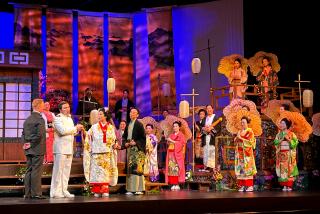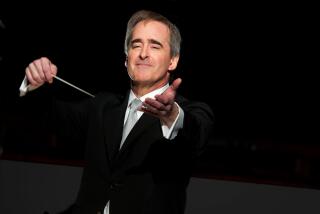Music : London Classical Players Make Southland Debut
- Share via
The Orange County Philharmonic Society had the good fortune to host the Southland debut on Saturday of the hugely successful, controversial London Classical Players under conductor Roger Norrington.
Norrington & Co. are part of a movement dedicated to respecting long-dead composers’ presumed intentions by scraping obfuscating interpretive overlay from their scores.
With this particular ensemble there is a difference: Its hackle-raising specialty is taking popular 19th-Century repertory--on Saturday by Beethoven, Schubert and Mendelssohn--rather than the relative esoterica of the Baroque and Classical eras and subjecting it to thorough cleansing.
Apparent in the welcoming acoustic of the Orange County Performing Arts Center was that the Classical Players sound is less alien live than on recordings. Such elements as the (on disc) overbearing shotgun blasts of the old timpani, played with hard sticks, retain their impact in the hall but are better integrated with the ensemble, while the gut strings sound less pinched, more sweetly plaintive, and the brass less raucous.
Balances are just, but instrumental choirs retain their individual timbres and the light-toned solo winds sound clearly in Norrington’s well-thought-out seating arrangement: horns and trumpets (valveless, of course) on opposite edges of the stage, basses divided in half over a similar span, winds at top center, first violins to his left, seconds to his right.
The amount of orchestral detail heard in Mendelssohn’s once-familiar-in-concert and, as was proven Saturday, still-ravishing “Scottish” Symphony was startling. Here, too, Norrington blasted the canard that he is a compulsive speedster. The slow movement sang gently, elegantly, the vibratoless strings’ quick attack and release maintaining the lyric line where usually their sound hangs endlessly in the air, obscuring pitch and impeding momentum.
Earlier, Norrington and his crew fleetly dispatched Schubert’s Fourth Symphony (“Tragic”), attentive not to the Romantic images conjured up by the nickname or imagined Beethoven associations, but rather to the outer movements’ ancestry in Sturm und Drang Haydn.
More to Read
The biggest entertainment stories
Get our big stories about Hollywood, film, television, music, arts, culture and more right in your inbox as soon as they publish.
You may occasionally receive promotional content from the Los Angeles Times.










